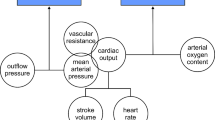Abstract
Considering the heart as a physical pump cardiac efficiency is calculated from the ratio of cardiac work performed to the maximum level of energy of the heart. The aim of the study was to compare cardiac efficiency with cardiac output and right ventricular ejection fraction. Nine patients scheduled for coronary artery bypass grafting were investigated. A femoral arterial and a right ventricular ejection fraction pulmonary artery catheter were placed in the awake state. Anaesthesia was induced with eltanolone and fentanyl. Cardiac output, pulmonary artery and central venous pressures, and right ventricular ejection fraction were measured in the awake state (baseline), 2 min after induction of anaesthesia and 1 and 5 min after intubation. Cardiac effeciency was calculated by dividing the stroke work by the maximum energy of the heart as calculated from the pressure volume diagram. An analysis of variance was carried out for cardiac efficiency, cardiac output and right ventricular ejection fraction. Cardiac efficiency was significantly (p<0.05) reduced 1 min after intubation from 28±11 to 14±5%. In contrast the right ventricular ejection fraction (from 48±10 to 35±13%) and cardiac output (from 6.5±1.5 to 5.3±1.2L/min) did not change significantly during the induction of anaesthesia. Cardiac efficiency was found to be a more sensitive parameter to describe changes in the right ventricular function than the ejection fraction and cardiac output during induction of anaesthesia with eltanolone and fentanyl which was used as a model to vary cardiac performance and afterload.
Similar content being viewed by others
References
Kunig H. Druck-Volumen Kurven Diagnose. Anaesthesist 1994;43Suppl. 1:260 [abstract]
Hemelrijk JV, Muller P, Van Aken H, White PF. Relative potency of Eltanolone, Propofol, and Thiopental for induction of anesthesia. Anesthesiology 1994;80:36–41.
Powell H, Morgan M, Sear JW: Pregnanolone: a new steroid intravenous anaesthetic. Dose-finding study. Anaesthesia 1992;47:287–90.
Tassani P, Groh J, Ott E, Jänicke U, Haessler R, Peter K: Eltanolone, a new induction agent—hemodynamic effects in patients with coronary artery disease compared to thiopentone [abstract]. Anesthesiology 1993;79:A328.
Suga H Extemal mechanical work from the relaxing ventricle. Am J Physiol 1979;236:H494–7.
Grossmann W, Barry WH Cardiac Catheterization. In: Braunwald E. Heart Disease A Textbook of Cardiovascular Medicine. 4. Edition, Philadelphia: Saunders WB, 1992;178–204.
Hoel BL Some aspects of the clinical use of thermodilution in measuring cardiac output. Scand J Clin Lab Invest 1978;38:383.
Redington AN, Gray HH, Hodson ME, Rigby ML, Oldershaw PJ. Characterisation of the normal right ventricular pressure-volume relation by biplane angiography and simultaneous micromanometer pressure measurements. Br Heart J 1988;59:23–30.
Gorcsan J, Gasior TA, Mandarino WA, Deneault LG, Hattler BG, Pinsky MR. Assessment of the immediate effects of cardiopulmonary bypass on left ventricular performance by on-line pressure-area relations. Circulation 1994;89:180–90.
Gorcsan J, Morita S, Mandarino WA. Two-dimensional echocardiographic automated border detection accurately reflects the changes in left ventricular volume. J Am Soc Echocardiogr 1993;6:482–9.
Schreuder JJ, Biervliet JD, van der Velde ET. Systolic and diastolic pressure-volume relationships during cardiac surgery. Journal of Cardiothoracic and Vascular Anesthesia 1991;5:1–6.
Shoucri RM. Pressure-volume relation in the right ventricle. J Biomed Eng 1993;15:167–9.
Soucri RM. Performance of left ventricle based on pressure-volume relation. J Biomed Eng 1990;12:482–8.
Brown KA, Ditchey RV. Human right ventricular end-systolic pressure-volume relation defined by maximal elastance. Circulation 1988;78:81–91.
Suga H, Yasumura Y, Nozawa T, Futaki S, Igarashi Y, Goto Y. Prospective prediction of O2 consumption from pressure-volume area in dog hearts. Am J Physiol 1987;252:H1258-H1268.
Author information
Authors and Affiliations
Rights and permissions
About this article
Cite this article
Tassani, P., Jänicke, U., Kunig, H. et al. Evaluation of right ventricular function by assessment of cardiac efficiency: Influence of induction of anaesthesia in coronary artery bypass grafting patients. J Clin Monitor Comput 12, 169–173 (1995). https://doi.org/10.1007/BF02332691
Accepted:
Issue Date:
DOI: https://doi.org/10.1007/BF02332691




